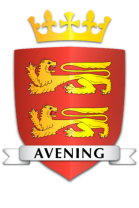

© Avening Parish Council 2022
“Preserve, Conserve, Enhance”
Welcome
Avening History pages
The Medieval Village of Avening has a rich and varied past - it grew around the Norman Church of the Holy Rood (or Holy Cross), which was built on the site of an earlier Saxon Church. It is said to have been built in 1080, being the only church ever to be built by a Queen of England. During the Second World War, Avening lay on GHQ Line. Extensive anti-tank ditches were constructed to the south and southeast, and were overlooked by a number of pillboxes. The defences were constructed as a part of British anti-invasion preparations.

Census information - 1841 to 1911
We have transcribed the census information from 1841 to 1911, so that you are able to search and download all of the records to help with your family trees or general research. You will find guidance notes, a searchable index, and the full record for each census.

Avening in the First World War
In Avening Parish Church, the Roll of Honour shows that the village lost 42 men in the First World War. Many of the family names can still be found among the current inhabitants of Avening. Military records list a total of 87 men serving in the forces during the first year of the war. This was from a total population of 823 in 1914. The hamlet of Nag’s Head alone sent 17 men from only 18 houses. Most of the men served in the Gloucestershire Regiment; some were in other regiments or the Royal Navy. One Baptist minister, the Reverend Edward Fowles, who had been working as a missionary in China, was enlisted as an officer in the Chinese Labour Battalions in France because of his knowledge of Chinese customs and language. Avening men fought in nearly all the theatres of the war, from Flanders to Mesopotamia. Those who died were killed in action or fatally wounded at Ypres, Loos, Cambrai, Arras, the Dardanelles and many other places. Some were decorated for their bravery, with at least three Military Medals and two Distinguished Conduct Medals being awarded to local men. Click on the WW1 Heroes link to read the stories of the 42 men who died in the conflict

Avening people
Looking at the charactors and people who have lived in Avening
AveningHistory pages





Avening places
Historic pictures and views of the village showing the changes that have happened in the development of Avening






https://1drv.ms/u/s!ApE9_E6npYmIgaJe-2yJzgReOgbquA?e=woywBc


© Avening Parish Council 2022
ABOUT
Avening History pages
The Medieval Village of Avening has a rich and varied past - it grew around the Norman Church of the Holy Rood (or Holy Cross), which was built on the site of an earlier Saxon Church. It is said to have been built in 1080, being the only church ever to be built by a Queen of England. During the Second World War, Avening lay on GHQ Line. Extensive anti-tank ditches were constructed to the south and southeast, and were overlooked by a number of pillboxes. The defences were constructed as a part of British anti-invasion preparations.
AveningHistory pages


Census information - 1841 to 1911
We have transcribed the census information from 1841 to 1911, so that you are able to search and download all of the records to help with your family trees or general research. You will find guidance notes, a searchable index, and the full record for each census.

Avening in the First World War
In Avening Parish Church, the Roll of Honour shows that the village lost 42 men in the First World War. Many of the family names can still be found among the current inhabitants of Avening. Military records list a total of 87 men serving in the forces during the first year of the war. This was from a total population of 823 in 1914. The hamlet of Nag’s Head alone sent 17 men from only 18 houses. Most of the men served in the Gloucestershire Regiment; some were in other regiments or the Royal Navy. One Baptist minister, the Reverend Edward Fowles, who had been working as a missionary in China, was enlisted as an officer in the Chinese Labour Battalions in France because of his knowledge of Chinese customs and language. Avening men fought in nearly all the theatres of the war, from Flanders to Mesopotamia. Those who died were killed in action or fatally wounded at Ypres, Loos, Cambrai, Arras, the Dardanelles and many other places. Some were decorated for their bravery, with at least three Military Medals and two Distinguished Conduct Medals being awarded to local men. Click on the WW1 Heroes link to read the stories of the 42 men who died in the conflict



Avening places
Historic pictures and views of the village showing the changes that have happened in the development of Avening

Avening people
Looking at the charactors and people who have lived in Avening








































